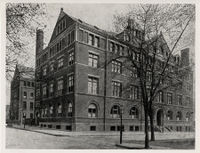| Beta Sigma | |
|---|---|
| BΣ | |
 | |
| Founded | May 20, 1905 |
| College | Adelphi College, now Adelphi University |
| Location | Garden City, NY |
| Homepage | http://www.kappa.org |
| Media related to Beta Sigma Chapter | |
|
Beta Sigma Chapter, Adelphi College
Total initiates: 417 Some of Beta Sigma’s Outstanding Alumnae: (If you have chapter alumna who have received recognition in any of these three categories, please list them with the date(s) of recognition.) Fraternity Council Officers: Juliette Hollenback , Grand Registrar 1910-1912; Grace Broadhurst (Robinson), Grand Registrar 1912-1914; Katherine Tobin Mullin, Editor of The Key1914-1922; Rosalie B. Geer Parker Editor of The Key 1922-926.
Fraternity Loyalty Award Recipients: Lois Catherman Heenehan, 2002, for her longtime service as an adviser to Delta Phi Chapter— Bucknell; Province Director of Chapters; and Associate Editor of The Key and Editorial Board member for four decades.
Fraternity Alumnae Achievement Award Recipients: Ruth Fanshaw Waldo, 1952, Vice president of J. Walter Thompson Advertising Agency; member of Adelphi College Board of Trustees
Additional Outstanding Beta Sigma Alumnae: Marie Beynon Lyons Ray, author and editor of vogue; Ida Poole Brown Pattrick, civic worker; Betty Ann White Selby; B. Geer Parker, active in civic work as well as served as Editor of The Key
The Early Years (From The History of Kappa Kappa Gamma 1870–1976)Charter members: Grace Adele Broadhurst, Elizabeth Miller Brown, Mary Kirk Flagler, Ethel Harnet Gauvran, Juliette Geneva Hollenbach, Katherine Fitzpatrick Tobin, Edna Jessie Wakefield, Edith Belle Wall. When Katherine Tobin Mullin wrote the history of Beta Sigma in 1930, she ended with “ … In about thirty-years one of those Beta Sigmas of the future will be asked to write something about the years of Beta Sigma in the ‘new Adelphi’.” It is somewhat eerie to read those words so many years later and to attempt to continue the history she lovingly and carefully compiled, especially since the chapter is no longer active. Adelphi began as a young ladies’ academy in Brooklyn, New York in 1869; became a college in 1896; moved to suburban Garden City, New York in 1929; and attained university status in 1960. Additional buildings, faculty and students have filled the wide expanse of lawns. Dormitories are among these new buildings, though Adelphi is still largely a commuting school and draws most of its students from the suburban communities of Long Island. The hope that became Beta Sigma Chapter began with Ethel Guavran (Smith) in 1903. She and a few special friends formed a little group called “Question Mark,” meaning “When will we be Kappas?” There was never any other thought in their hearts, and in 1905, their dream was realized when the chapter was installed. They were aided by a teacher, Elizabeth Rhodes, Cornell, in establishing the first Greek women’s fraternity chapter on the Adelphi campus. Beta Sigma was known as “the singing chapter” and contributed songs that are still sung: “Kappa All Hail to Thee,” “Kappa Memories,” and “Not Thy Key, O Kappa.” House party weekend was a chapter tradition. The members stayed at the country home of one of the girls and always enjoyed the opportunity to live and work together more closely. Senior Summer and Parents Tea were other annual events and supper meetings in the faculty dining room provided great opportunities for sisterhood, even if the culinary results were sometimes doubtful.
World War IIDuring the years of World War II, the chapter actively participated in service activities and fundraising, as well as contributing knitted articles to Nora Waln’s* collections for war ophans. Participation in May Day activities were a must and there were always Kappas among the queen’s court, if not actually reigning over the day’s festivities and competitions among the Greeks. Beta Sigmas served as class presidents; were active in sports; served on the yearbook staff; presided over Panhellenic; worked in the student association; were members and officers in many clubs; were elected to various honorary scholastic fraternities; were chosen for Who’s Who in American Colleges and Universities; and served as Adelphi Alumnae Association officers and on the board of trustees of the school. Despite the many varied and outstanding contributions of its members, the chapter found it increasingly difficult to function properly on the Adelphi campus. The alumnae found it difficult to support the chapter actively after its move to Garden City. Campus development did little to provide facilities, especially for women, after the school became coeducational in 1945. Several school programs offered limited time on campus and lack of administrative planning for extracurricular activities in the overall college program eventually caused a lack of time, place and opportunity to meet and work together. Application to surrender the charter was made in April 1954, and the final acceptance came in September, 1955. While Beta Sigma’s chapter history is complete, that does not mean that Beta Sigmas have disappeared from the scene. Since many bound archival volumes of The Key were damaged in a fire at Fraternity Headquarters, the issues for 1905-1928 stamped with Beta Sigma are displayed in the Fraternity archives. On the Adelphi campus, Waldo Hall is a visible reminder of the many Kappas who have contributed to the college and later to the world. The charter may be gone, but the feelings, beliefs and sisterhood that the members of Beta Sigma Chapter have felt over the years continue.
|